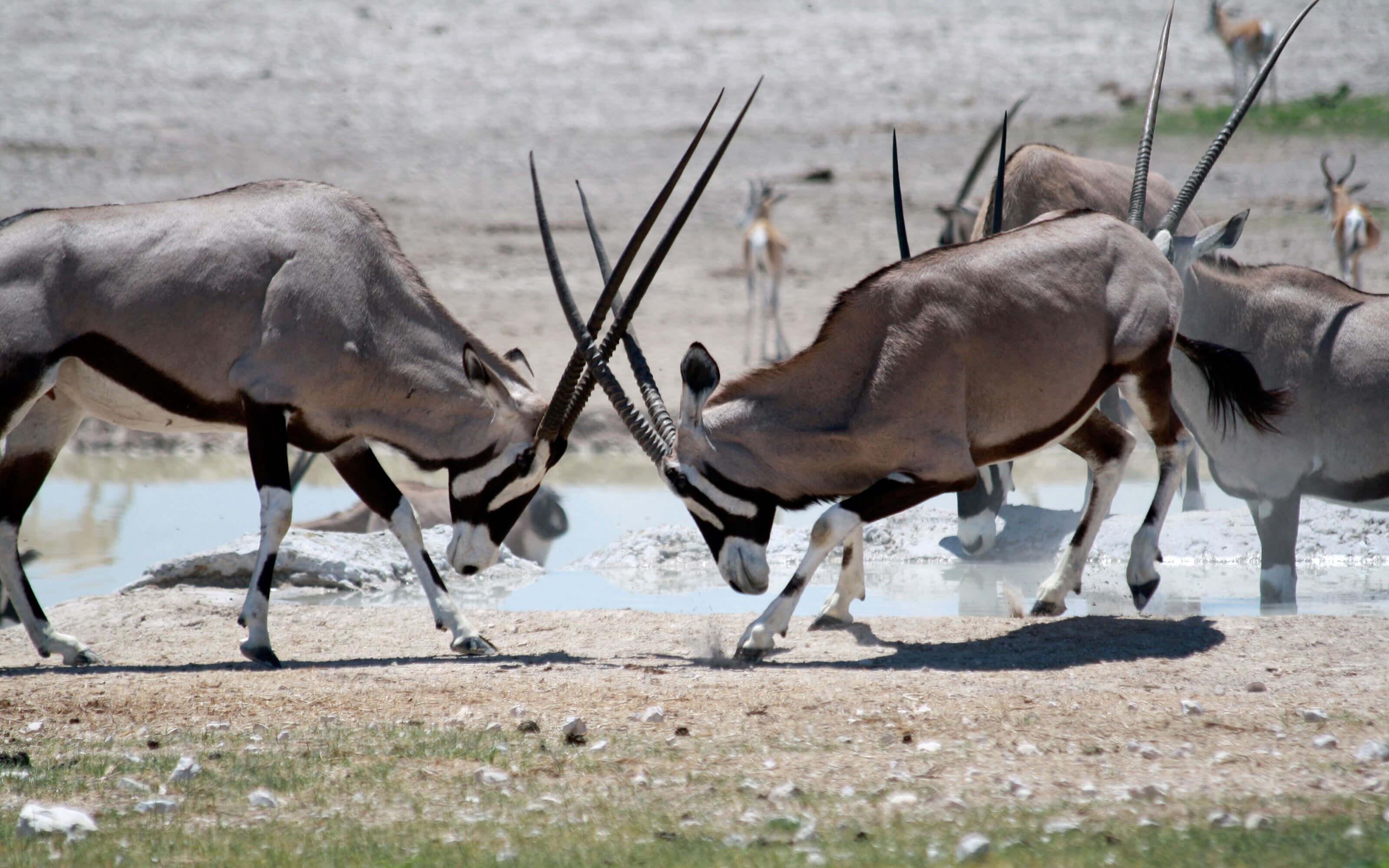We know, we know: Tanzania is rightly famous for being one of the best places to spot lions, cheetahs and leopards, while its wetlands and grassy plains boast an even larger cast of characters, including zebras, elephants and giraffes. But the country’s bestial bounty extends well beyond its most famous residents. Get to know a few of the lesser-known – but equally spectacular – animals to keep an eye out for when visiting Tanzania.
Banded Mongoose

Also called a Mungos mungo (aka “the African animal so nice, they named it twice”), pack life is important to these small carnivores, which live in groups of roughly 20 animals and sleep together at night in underground dens. All the pack members take care of the pups, the mothers suckle each other’s offspring indiscriminately, and each young pup has an adult “escort” that catches prey for it.
Oryx

Also pictured above, the African oryx have is a subspecies of antelopes that strikes an imposing appearance thanks to its long, distinctive horns. Don’t let their docile disposition fool you though; their long horns are a serious weapon—earning them the nickname “sabre antelopes.”
Dik-diks

Though they look like miniature deer, dik-diks are small antelopes that never get bigger than 30 to 40 cm (12 to 16 in) and weigh only 3 to 6.8 kg (7 to 15 lbs). When sensing danger, the female warns other game species in the area that it’s time to flee by emitting a nose whistle that sounds like “zik-zik” or “dik-dik.” These travel-sized antelopes are capable of reaching speeds of up to 67.5 km (42 mi) per hour.
Lesser Kudus

To glance a lesser kudu is to immediately understand how inappropriately they were named—there’s nothing lesser about these majestic, chestnut-coloured antelopes with 11 to 14 white stripes on their back. These athletic beasts can hurdle distances of more than 9 m (30 ft) long and jump more than 2.5 m (8.2 ft) high. Oh, and they can also reach speeds of around 100 km (62 mi) per hour. We’re not sure how fast a “regular kudu” can run, but we doubt it’s as fast as a car.
Blue Wildebeest

Fossil records suggest two wildebeest species diverged about one million years ago, resulting in a northern species and a southern species. The blue wildebeest changed very little from the ancestral species, while the black wildebeest changed more to adapt to its open grassland habitat in the south.
Black Rhinos: An Uncertain Future
Admittedly the most famous breed on this list, it was only relatively recently that rhinos garnered more widespread attention—and for potentially catastrophic reasons.
Population Devastation
Twenty years ago, visitors to Tanzania rarely paid much attention to black rhinos. The animals usually made a nuisance of themselves, charging unexpectedly through the bushes of parks, interrupting bird watching or disturbing other animals at waterholes. They were regarded as rather stupid beasts, with little personality and less beauty. Today it is a totally different story, and the black rhino is now second to lions on the list of animals visitors most want to see.
Between 1970 and 1984, East Africa lost 85% of its rhino population. In the 60s there were 109 rhinos in the Ngorongoro Crater and today there are 26. Many rhinos succumbed to the terrible drought of 1971 and actually starved to death, while others fell to poisoned arrows and bullets from a range of rifles—including Kalashnikovs.
The Culprit
Pundits claimed the poaching was due to a demand in the Far East for rhino horns as an aphrodisiac. This, however, is not the whole truth; the main culprits are found in one of the poorest countries in the world, North Yemen. This country had been closed to the outside world and ruled by the whims of autocratic imams until civil war broke out in 1962. Soon after, the Yemenis became part of the monied economy and by 1978 the locals were able to buy all the things that they wanted. Among other coveted possessions were daggers with rhino horn handles—formerly the status symbol of the imams and their cronies, and available only in very limited numbers.
Between 1972 and 1978 North Yemen imported about 28 tonnes of rhino horns, approximately 40% of all the horn on the market. It was due to the Yemeni’s huge demand for rhino horns that prices rose to $500 a kilo by 1979. So it is not surprising that the elephant poachers switched to hunting rhinos as a more lucrative enterprise; the other benefit is that it is easier to kill a rhino and hide the horn, compared to elephant tusks, who have much bigger tusks and leave much larger carcasses.
While the Yemenis made up most of the demand, some cultures in the Far East did want the horn, and contributed to the population decline. Their main use for it was medicinal, believing that it is capable of curing a multitude of human ailments. In some parts of Asia, it was used as an aspirin, supposedly curing anything from simple headaches to dangerously common ailments. Rhino horns in these countries can be purchased in the form of tonics, tablets and powders. The horn of the black rhino (and the white rhino) consists of a tightly packed mass of hair-like filaments and can grow to a length of 1.2 m (3.9 ft) for the front horn, and about half a metre for the rear horn.
What’s Being Done?
A great deal of money, manpower and equipment is being invested to protect the rhino population. Isolated rhinos are being relocated into selected areas of private ranches, reserves and parks. Anti-poaching techniques are being improved and there are stricter prison sentences if the poachers are caught.






